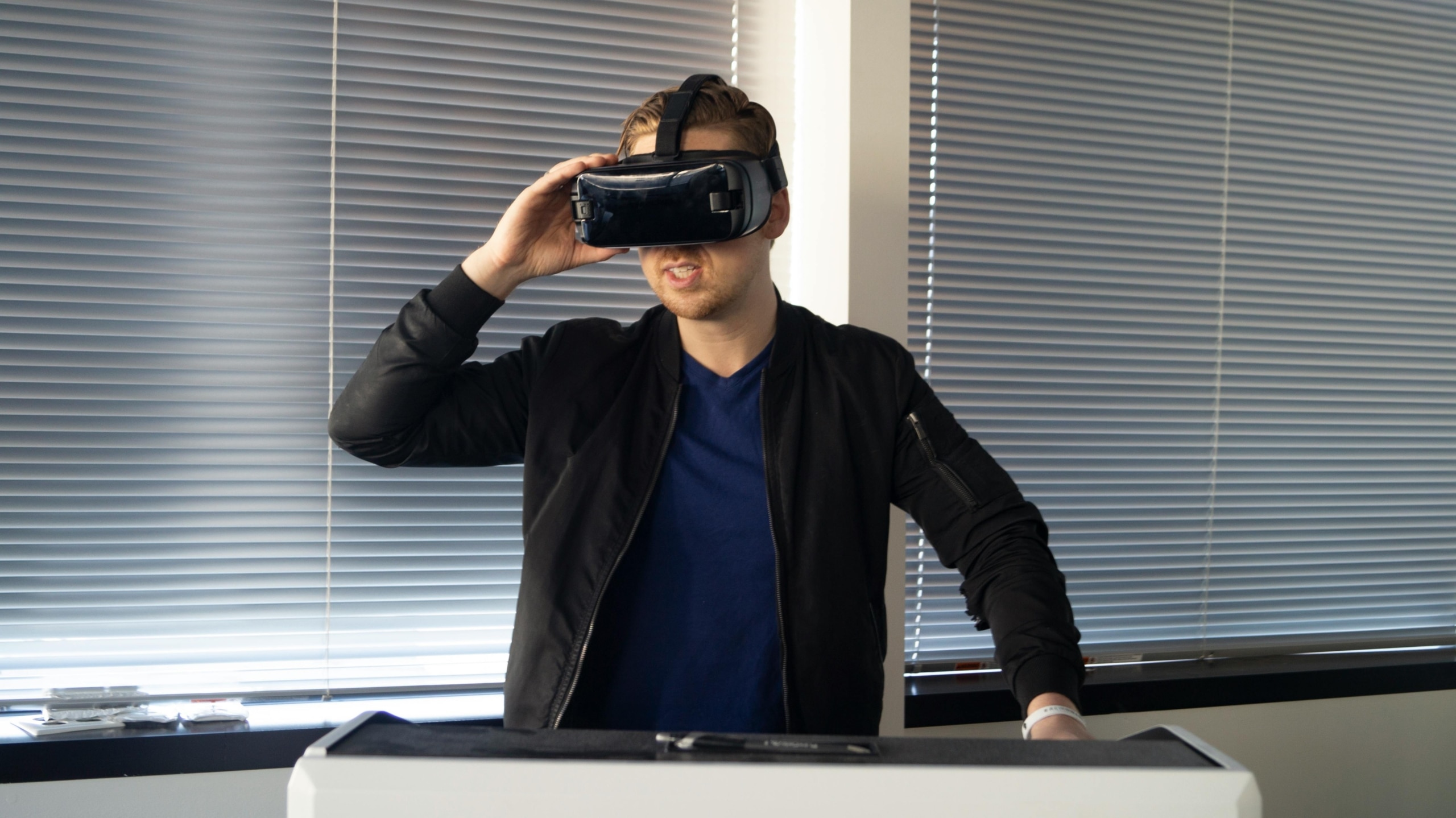
VR vs Virtual Tours: Which is Right for Your Business?
Understanding the Difference Between VR and Virtual Tours
The terms “VR” and “virtual tours” are often used interchangeably, but they represent fundamentally different technologies with distinct business applications. Understanding the difference between VR vs virtual tours is crucial for making the right investment in your business’s digital marketing strategy. While both technologies create immersive experiences, they serve different purposes, require different equipment, and deliver different results for businesses.
Virtual reality (VR) requires specialized headsets and creates completely artificial environments, while virtual tours use standard devices to showcase real spaces through 360° photography. The choice between VR vs virtual tours depends on your business goals, target audience, budget, and practical implementation needs. This comprehensive guide explores both technologies to help you determine which solution best serves your business objectives.
What is Virtual Reality (VR) for Business?
VR Technology and Requirements
Virtual reality creates completely immersive, computer-generated environments that users experience through specialized headsets like Oculus, HTC Vive, or PlayStation VR. VR technology blocks out the real world entirely, placing users in artificial 3D environments where they can interact with digital objects and navigate synthetic spaces.
For businesses, VR typically involves creating custom 3D models and environments rather than capturing real spaces. This technology requires significant development time, specialized software, expensive equipment, and ongoing technical support to create and maintain effective business applications.
VR experiences demand dedicated hardware that customers must wear, creating barriers to casual browsing and requiring businesses to provide equipment or expect customers to own VR headsets. The complexity and cost of VR implementation make it suitable only for specific business applications with clear return on investment.
VR Business Applications and Use Cases
VR excels in training simulations, product demonstrations, and entertainment experiences where artificial environments provide advantages over real spaces. Industries like healthcare, aviation, and manufacturing use VR for employee training in scenarios that would be dangerous, expensive, or impossible to replicate in real life.
Real estate developers sometimes use VR to showcase properties that haven’t been built yet, allowing potential buyers to experience planned developments before construction begins. Automotive companies use VR for virtual test drives and configuration experiences that let customers explore vehicles in detail.
However, VR’s complexity and equipment requirements limit its effectiveness for most day-to-day business marketing needs. The technology works best for specialized applications where the immersive experience justifies the additional complexity and cost.
What are Virtual Tours for Business?
Virtual Tour Technology and Accessibility
Virtual tours use 360° photography to capture real spaces, allowing viewers to explore actual business locations through standard devices like smartphones, tablets, and computers. This technology requires no special equipment from viewers and works seamlessly across all modern devices and web browsers.
Virtual tours are created by professional photographers using specialized 360° cameras to capture complete spherical images of real spaces. These images are then stitched together and hosted on platforms that enable smooth navigation between different viewpoints, creating comprehensive walkthroughs of actual business locations.
The accessibility of virtual tours makes them ideal for business marketing because customers can explore your space instantly, without downloads, apps, or special equipment. This immediate accessibility dramatically increases engagement and allows virtual tours to work as effective marketing tools 24/7.
Virtual Tour Business Applications and Benefits
Virtual tours excel at showcasing real business spaces to potential customers, helping them make confident decisions about visiting, purchasing, or booking services. Restaurants use virtual tours to display dining atmospheres, hotels showcase rooms and amenities, and retail stores highlight merchandise and layout.
Real estate agents use virtual tours to provide comprehensive property previews that attract serious buyers and reduce unnecessary showings. Event venues use virtual tours to help couples envision their weddings and corporate planners evaluate spaces for meetings and conferences.
The immediate accessibility and realistic representation make virtual tours particularly effective for building customer trust and confidence. When customers can explore your actual space before visiting, they arrive with accurate expectations and higher likelihood of making positive decisions.
VR vs Virtual Tours: Technical Comparison
Equipment and Infrastructure Requirements
VR requires expensive specialized equipment including headsets, controllers, powerful computers, and often dedicated physical space for safe movement. Businesses must either provide this equipment on-site or expect customers to own VR hardware, creating significant barriers to adoption.
Virtual tours require no special equipment from viewers beyond standard internet-connected devices. Businesses need only professional 360° photography and web hosting, making virtual tours immediately accessible to virtually all potential customers.
The technical infrastructure for VR includes powerful graphics processing, specialized software development, and ongoing maintenance of complex systems. Virtual tours use standard web technologies that work reliably across all devices and require minimal technical maintenance.
Development Time and Complexity
VR experiences require extensive development time, often taking months to create custom 3D environments, implement interaction systems, and test across different VR platforms. This complexity demands specialized developers and significant ongoing technical support.
Virtual tours can be created and deployed within days, requiring only professional photography and standard web development. The streamlined creation process allows businesses to launch virtual tours quickly and update them easily as spaces change.
VR development costs can range from tens of thousands to hundreds of thousands of dollars for custom business applications, while virtual tours typically cost a fraction of that amount and provide immediate return on investment.
User Experience and Engagement
VR provides highly immersive experiences but requires users to commit significant time and effort to don equipment and navigate complex interfaces. This commitment creates barriers that limit casual exploration and reduce overall audience reach.
Virtual tours offer immediate engagement that users can access instantly from any device. The familiar navigation and instant accessibility encourage exploration and sharing, leading to broader reach and higher conversion rates.
While VR creates more immersive experiences, virtual tours provide more practical engagement that aligns with how customers actually research and make purchasing decisions in their daily lives.
Cost Analysis: VR vs Virtual Tours
Initial Investment Requirements
VR implementation requires substantial upfront investment in hardware, software development, and infrastructure. Custom VR experiences for businesses typically cost $50,000-$500,000 or more, depending on complexity and features.
Virtual tours require significantly lower initial investment, with professional services starting at $99 per month for comprehensive packages including photography, hosting, and ongoing support. This accessible pricing allows businesses of all sizes to benefit from immersive marketing technology.
The return on investment timeline for VR can extend over several years due to high initial costs, while virtual tours typically demonstrate positive ROI within the first few months through increased customer engagement and conversions.
Ongoing Costs and Maintenance
VR systems require ongoing maintenance, software updates, hardware replacement, and technical support. The complexity of VR technology means ongoing costs can be substantial and unpredictable.
Virtual tours require minimal ongoing maintenance, with professional services typically including hosting, updates, and technical support in monthly packages. This predictable cost structure helps businesses budget accurately for long-term success.
The total cost of ownership for VR systems often exceeds initial estimates due to unexpected technical issues and upgrade requirements, while virtual tours provide transparent, all-inclusive pricing that eliminates cost surprises.
Return on Investment Comparison
VR return on investment is often difficult to measure and may not justify costs for most businesses. The limited audience reach and high implementation costs make positive ROI challenging to achieve for typical business marketing applications.
Virtual tours demonstrate clear, measurable ROI through increased website engagement, higher conversion rates, reduced customer service inquiries, and improved booking rates. Most businesses see positive returns within 90 days of implementation.
The accessibility and broad reach of virtual tours create multiple opportunities for return on investment, while VR’s limited accessibility restricts potential returns to specialized use cases.
Target Audience and Accessibility: VR vs Virtual Tours
Customer Demographics and Technology Adoption
VR appeals primarily to technology enthusiasts and younger demographics who own or are willing to use VR equipment. This limited audience restricts VR’s effectiveness for businesses targeting broader customer bases.
Virtual tours appeal to all demographics because they work on devices everyone already owns and uses. From tech-savvy millennials to older customers who prefer familiar interfaces, virtual tours provide universal accessibility.
The demographic limitations of VR make it unsuitable for most business marketing applications, while virtual tours effectively reach entire target markets regardless of age, technical skill, or equipment ownership.
Device Compatibility and Usage Patterns
VR requires specific, expensive hardware that most consumers don’t own. Even among VR headset owners, usage tends to be infrequent and primarily focused on gaming rather than business research.
Virtual tours work on smartphones, tablets, computers, and any device with a web browser. This universal compatibility aligns with how customers actually research businesses and make purchasing decisions.
Customer research patterns favor quick, accessible information gathering rather than complex, time-intensive VR experiences. Virtual tours match these patterns perfectly, while VR creates friction that discourages casual exploration.
Mobile Usage and On-the-Go Access
VR cannot provide mobile experiences in the traditional sense, as headsets require stationary use in safe environments. This limitation prevents customers from exploring VR content while commuting, during lunch breaks, or in other common research scenarios.
Virtual tours excel on mobile devices, allowing customers to explore businesses anywhere, anytime. This mobile accessibility is crucial because most local business research happens on smartphones.
The mobile optimization of virtual tours enables sharing via social media, text messages, and other mobile communication methods, dramatically expanding their marketing reach compared to VR experiences.
Industry-Specific Applications: VR vs Virtual Tours
Restaurant and Hospitality Industry
Restaurants benefit enormously from virtual tours that showcase actual dining atmospheres, table arrangements, and ambiance. Customers can evaluate restaurants before visiting, leading to more confident reservations and reduced cancellations.
VR offers limited benefits for restaurants because customers want to see actual spaces, not artificial representations. The equipment requirements also make VR impractical for casual restaurant research and reservation decisions.
Hotels and event venues particularly benefit from virtual tours that display real rooms, amenities, and event spaces. The immediate accessibility allows customers to explore properties instantly, improving booking rates and customer satisfaction.
Real Estate Applications
Real estate virtual tours provide comprehensive property previews that attract serious buyers and reduce unnecessary showings. The realistic representation helps buyers understand layouts, flow, and features before scheduling visits.
VR in real estate is primarily useful for properties that don’t exist yet, allowing developers to showcase planned developments. However, for existing properties, virtual tours provide superior value through realistic representation and universal accessibility.
The immediate accessibility of virtual tours aligns perfectly with real estate marketing timelines and buyer research patterns, while VR’s complexity creates barriers that can slow the sales process.
Retail and Commercial Businesses
Retail businesses use virtual tours to showcase store layouts, merchandise displays, and shopping environments. Customers can preview stores before visiting, leading to more targeted shopping trips and improved customer experiences.
VR offers limited practical applications for retail businesses because customers need to see actual products and current inventory rather than artificial representations. The equipment barriers also prevent casual shopping exploration.
Commercial properties benefit from virtual tours that demonstrate space functionality, layouts, and features to potential tenants. The accessibility allows multiple stakeholders to evaluate properties efficiently without scheduling conflicts.
Implementation Challenges: VR vs Virtual Tours
Technical Complexity and Support Requirements
VR implementation requires specialized technical expertise, ongoing software development, and complex troubleshooting when issues arise. Most businesses lack the internal resources to manage VR systems effectively.
Virtual tours use standard web technologies that integrate easily with existing websites and marketing systems. The technical simplicity ensures reliable performance and reduces support requirements.
VR’s technical complexity often leads to unexpected costs and delays, while virtual tours provide predictable implementation timelines and reliable performance from day one.
Staff Training and Customer Education
VR requires extensive staff training to support customers using equipment and troubleshoot technical issues. Customer education is also necessary to help users navigate VR interfaces effectively.
Virtual tours require minimal staff training because they work like familiar websites and mobile apps. Customers need no education or assistance to explore virtual tours independently.
The learning curve for VR creates barriers for both staff and customers, while virtual tours leverage existing digital literacy and require no additional training.
Content Creation and Updates
VR content creation requires specialized 3D modeling, programming, and extensive testing across different platforms. Updates and modifications can be complex and expensive to implement.
Virtual tour content creation involves professional photography and standard web development. Updates are straightforward and can be implemented quickly as businesses change or evolve.
The complexity of VR content management makes it difficult to keep experiences current, while virtual tours can be updated easily to reflect business changes, seasonal decorations, or new features.
Making the Right Choice: VR vs Virtual Tours Decision Framework
Assessing Your Business Goals
Consider whether your primary goal is marketing real spaces to customers or creating specialized training and simulation experiences. Virtual tours excel at marketing actual business locations, while VR serves specialized applications that require artificial environments.
Evaluate whether you need to reach broad customer audiences or serve specific, tech-savvy demographics. Virtual tours provide universal accessibility, while VR appeals to limited audiences with specialized equipment.
Determine whether immediate implementation and quick ROI are priorities, or whether you can invest in long-term, complex technology development. Virtual tours offer immediate benefits, while VR requires substantial time and investment before delivering results.
Budget and Resource Considerations
Assess your available budget for both initial implementation and ongoing maintenance. Virtual tours offer predictable, affordable pricing, while VR requires substantial upfront investment and unpredictable ongoing costs.
Consider your internal technical resources and support capabilities. Virtual tours require minimal technical management, while VR demands specialized expertise and ongoing technical support.
Evaluate your timeline for implementation and return on investment. Virtual tours can be implemented quickly with immediate benefits, while VR projects typically require months or years before delivering measurable results.
Customer Experience Priorities
Determine whether your customers need immediate, accessible information or would benefit from highly immersive, time-intensive experiences. Most business customers prefer quick, accessible exploration over complex, equipment-dependent experiences.
Consider how your customers actually research and make purchasing decisions. If they use smartphones and quick browsing sessions, virtual tours align with their behavior patterns better than VR experiences.
Evaluate whether your customer experience strategy emphasizes broad reach and accessibility or specialized, high-touch interactions. Virtual tours support broad customer engagement, while VR serves narrow, specialized use cases.
Why Virtual Tours Are the Right Choice for Most Businesses
Practical Business Benefits
Virtual tours provide immediate, measurable benefits for most businesses through increased customer engagement, improved conversion rates, and enhanced marketing effectiveness. The technology aligns with how customers actually research businesses and make purchasing decisions.
The universal accessibility of virtual tours ensures maximum audience reach and eliminates barriers that prevent customers from exploring your business. This accessibility translates directly to increased leads, bookings, and sales.
Virtual tours integrate seamlessly with existing marketing strategies, enhancing websites, social media, and advertising efforts without requiring customers to adopt new technologies or behaviors.
Cost-Effective Implementation
Virtual tours offer predictable, affordable pricing that provides immediate return on investment for businesses of all sizes. The transparent cost structure eliminates surprise expenses and enables accurate budget planning.
The quick implementation timeline allows businesses to start benefiting from virtual tours within days rather than months or years. This rapid deployment provides competitive advantages and immediate marketing benefits.
The comprehensive service packages available for virtual tours include everything needed for success, from professional photography to hosting and ongoing support, eliminating the need for businesses to manage complex technical systems.
Long-Term Value and Adaptability
Virtual tours provide lasting value that continues working 24/7 to attract and convert customers. Unlike VR systems that may become obsolete or require expensive upgrades, virtual tours remain effective and accessible as technology evolves.
The flexibility of virtual tours allows easy updates and modifications as businesses grow and change. Whether renovating spaces, adding new areas, or updating seasonal decorations, virtual tours adapt to business evolution.
Virtual tours support emerging technologies and platforms, ensuring your investment remains valuable as digital marketing continues advancing. The standard web technologies underlying virtual tours ensure long-term compatibility and effectiveness.
Professional Virtual Tour Services: Your Best Investment
Comprehensive Service Excellence
Professional virtual tour services provide complete solutions that eliminate the complexity and uncertainty associated with new technology adoption. Starting at just $99 per month, comprehensive virtual tour packages include professional photography, hosting, maintenance, and ongoing support.
The month-to-month flexibility ensures you’re never locked into long-term commitments while receiving enterprise-level service quality. This approach provides the benefits of cutting-edge technology without the risks associated with complex VR implementations.
Professional virtual tour services handle all technical aspects, allowing you to focus on your business while benefiting from immersive marketing technology that drives real results.
Proven Results and ROI
Businesses using professional virtual tours consistently report measurable improvements in customer engagement, reduced customer service inquiries, and increased conversion rates. The technology provides trackable results that justify investment and guide optimization efforts.
Unlike VR implementations that may take years to show results, virtual tours typically demonstrate positive ROI within the first 90 days through increased bookings, improved customer confidence, and enhanced online presence.
The broad accessibility and immediate appeal of virtual tours create multiple opportunities for return on investment, from increased website engagement to improved search engine rankings and enhanced social media marketing.
Future-Proof Technology Investment
Virtual tours represent future-proof technology that will remain relevant and effective as digital marketing continues evolving. The universal compatibility and standard web technologies ensure your investment maintains value over time.
Professional virtual tour services stay current with technology developments and best practices, ensuring your virtual tour remains competitive and effective without requiring you to manage complex technical updates.
The scalability of virtual tours allows your marketing technology to grow with your business, supporting expansion, additional locations, and evolving marketing strategies without requiring complete system replacements.
Getting Started with Virtual Tours: The Smart Choice
Immediate Implementation Benefits
Virtual tours can be created and launched within days, providing immediate marketing benefits and competitive advantages. The quick implementation timeline allows you to start attracting customers and improving conversion rates without lengthy development periods.
The professional consultation process ensures your virtual tour aligns with your business goals and marketing strategy from day one. Expert guidance eliminates guesswork and ensures optimal results from your technology investment.
Virtual tours integrate seamlessly with your existing website and marketing efforts, enhancing current strategies rather than requiring complete overhauls or customer behavior changes.
Measurable Success and Optimization
Professional virtual tour services provide comprehensive analytics and performance tracking that help you understand customer behavior and optimize marketing effectiveness. These insights guide business decisions and marketing strategies for continued improvement.
The transparent reporting and measurable results allow you to track return on investment and justify marketing expenditures with concrete data. This accountability ensures your technology investment delivers genuine business value.
Ongoing optimization recommendations help you maximize virtual tour effectiveness and adapt to changing customer preferences and market conditions.
Conclusion: Virtual Tours Deliver Real Business Results
The choice between VR vs virtual tours for most businesses is clear: virtual tours provide superior accessibility, affordability, and return on investment for real-world business marketing needs. While VR serves specialized applications in training and simulation, virtual tours excel at the fundamental business need of showcasing real spaces to potential customers.
Virtual tours align with how customers actually research businesses, make purchasing decisions, and share recommendations. The immediate accessibility and universal compatibility ensure maximum audience reach and eliminate barriers that limit VR effectiveness.
Ready to harness the power of virtual tours for your business? Contact Virtual Tours LLC today to discover how professional virtual tour services can transform your marketing effectiveness and customer engagement. With flexible month-to-month pricing starting at $99 and comprehensive service packages, we make it easy to implement cutting-edge marketing technology that delivers real results for your business.

vr vs virtual tours





